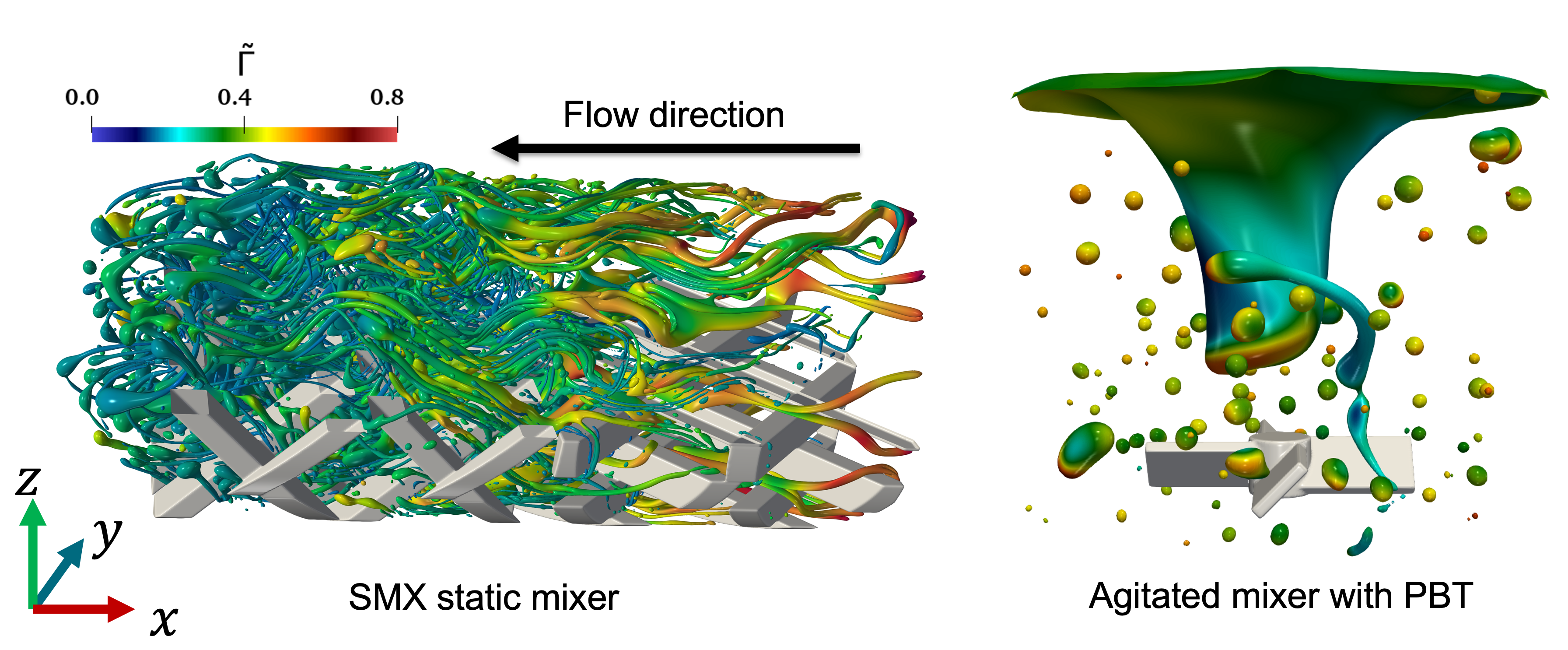2023 AIChE Annual Meeting
(371c) Machine Learning for Prediction and Optimization in Surfactant-Laden Liquid Dispersions
Authors
In addition, the prevalent scenario in industry, wherein surface active agents (surfactants) are present as contaminants or additives, elevates the complexity of predicting the surfactant-covered drop size (distribution). It is unsurprising, therefore, that no correlation thus far has been established to predict the drop size in the presence of surfactant. Fortunately, the rapid development of Artificial Intelligence (AI), data science, and machine learning provides a powerful toolkit to address the complexities described above in the field of multi-phase flow [Zhu et al., 2022]. Inspired by prior work, machine learning techniques are applied herein for the development of predictive models of the drop size given either the surfactant properties or mixer configurations.
In this study, high-fidelity simulations of surfactant-laden liquid dispersions obtained via use of static and agitated mixers are carried out to thoroughly investigate the underlying physical mechanisms governing the mixing dynamics (Figure 1). Our state-of-the-art numerical framework comprises a robust hybrid interface-tracking algorithm, along with a well-validated solver for surfactant transport in multi-phase flow field [Shin et al., 2018]. This grants us access to an unprecedented level of detail of the interfacial evolution in the presence of surfactants. Taking advantage of the drop size tracking and corresponding interfacial surfactant concentration profiles, the present work seeks to exploit supervised learning methods (i.e., Random Forest, XGBoost) to explore how the drop size is modulated dynamically by the interfacial tension, which is dependent on the concentration and physicochemical nature of the surfactant present. Our results show that, for both mixers, the drop size is strongly correlated to the average interfacial surfactant concentration while physicochemical properties and initial conditions (i.e., desorption coefficient, initial interfacial and bulk concentration) exert a relatively weak influence. Furthermore, semi-empirical drop size correlations from previous work in the literature are encoded into our machine learning algorithms with the aim of identifying the deviation between clean and surfactant-laden drop size predictions.
Finally, coarse simulations of mixers with various configurations are on-going to generate data to train a surrogate model for rapid prediction of mixer performance and thereby leading to mixer design optimization. More specifically, take agitated mixer as an example, effort is made on the pitched blade turbine, one of the most commonly used impeller type in industrial applications, where the effect of multiple design parameters (namely pitch angle, blade width, blade length, blade number, and clearance) will be studied. The surrogate model to be developed is expected to either predict drop size (or interfacial area) when certain mixer configuration is known, or provide guidance on mixer design given a specific metric, say, drop size distribution.
Acknowledgement
This work is supported by the Engineering and Physical Sciences Research Council, United Kingdom, through the EPSRC MEMPHIS (EP/K003976/1) and PREMIERE (EP/T000414/1) Programme Grants. O.K.M. acknowledges funding from PETRONAS and the Royal Academy of Engineering for a Research Chair in Multiphase Fluid Dynamics. We acknowledge HPC facilities provided by the Research Computing Service (RCS) of Imperial College London for the computing time. D.J. and J.C. acknowledge support through HPC/AI computing time at the Institut du Developpement et des Ressources en Informatique Scientifique (IDRIS) of the Centre National de la Recherche Scientifique (CNRS), coordinated by GENCI (Grand Equipement National de Calcul Intensif) Grant 2022 A0122B06721.
References
Richard V Calabrese, TPK Chang, and PT Dang. Drop breakup in turbulent stirred-tank contactors. part i: Effect of dispersed-phase viscosity. AIChE Journal, 32(4):657â666, 1986.
Reza Afshar Ghotli, Mohammad Reza Abbasi, AmirHossein Bagheri, Abdul Aziz Abdul Raman, Shaliza Ibrahim, and Huseyin Bostanci. Experimental and modeling evaluation of droplet size in immiscible liquid-liquid stirred vessel using various impeller designs. Journal of the Taiwan Institute of Chemical Engineers, 100:26â36, 2019.
A Giapos, Chrysostomos Pachatouridis, and Michael Stamatoudis. Effect of the number of impeller blades on the drop sizes in agitated dispersions. Chemical Engineering Research and Design, 83(12):1425â1430, 2005.
Matthias Kraume, Ansor G Ìabler, and Kai Schulze. Influence of physical properties on drop size distribution of stirred liquid-liquid dispersions. Chemical Engineering & Technol- ogy: Industrial Chemistry-Plant Equipment-Process Engineering-Biotechnology, 27(3): 330â334, 2004.
AW Pacek, S Chamsart, AW Nienow, and A Bakker. The influence of impeller type on mean drop size and drop size distribution in an agitated vessel. Chemical Engineering Science, 54(19):4211â4222, 1999.
D Sechremeli, A Stampouli, and M Stamatoudis. Comparison of mean drop sizes and drop size distributions in agitated liquidâliquid dispersions produced by disk and open type impellers. Chemical Engineering Journal, 117(2):117â122, 2006.
Seungwon Shin, Jalel Chergui, Damir Juric, Lyes Kahouadji, Omar K Matar, and Richard V Craster. A hybrid interface trackingâlevel set technique for multiphase flow with soluble surfactant. Journal of Computational Physics, 359:409â435, 2018.
Mohd Izzudin Izzat Zainal Abidin, Abdul Aziz Abdul Raman, and Mohamad Iskandr Mohamad Nor. Mean drop size correlations and population balance models for liq- uidâliquid dispersion. AIChE Journal, 61(4):1129â1145, 2015.
Genwen Zhou and Suzanne M Kresta. Correlation of mean drop size and minimum drop size with the turbulence energy dissipation and the flow in an agitated tank. Chemical Engineering Science, 53(11):2063â2079, 1998a.
Genwen Zhou and Suzanne M Kresta. Evolution of drop size distribution in liquidâliquid dispersions for various impellers. Chemical Engineering Science, 53(11):2099â2113, 1998b.

